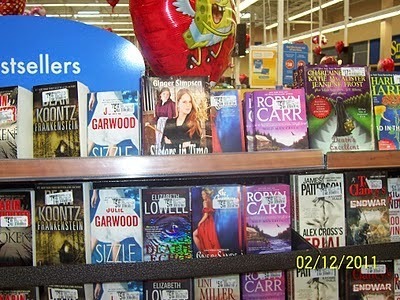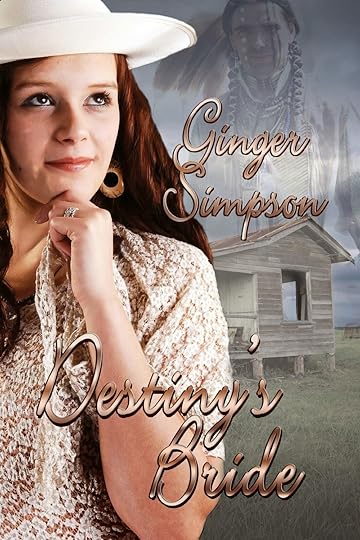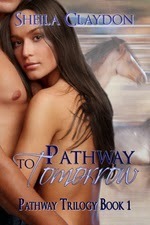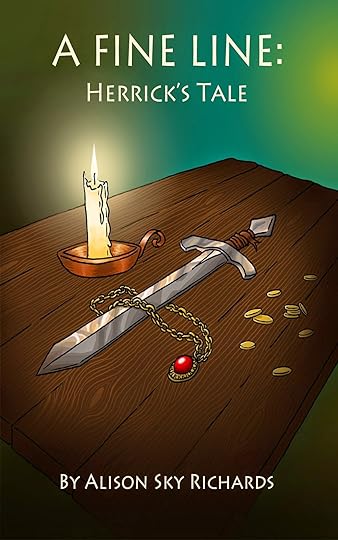Ginger Simpson's Blog, page 73
October 11, 2014
Ginger's Asking for a Little Help
 I don't usually enter contests that cost money, but I broke my own rule this time because being listed as one of 50 authors readers should know about appealed to me. I'm pretty sure there are people out there who recognize my name, but I want them to enjoy my work, so if you have a spare minute or two, I'm humbly asking you to visit the voting page, review the entrants, and vote your choice. I won't mind a bit if it happens to be me.
I don't usually enter contests that cost money, but I broke my own rule this time because being listed as one of 50 authors readers should know about appealed to me. I'm pretty sure there are people out there who recognize my name, but I want them to enjoy my work, so if you have a spare minute or two, I'm humbly asking you to visit the voting page, review the entrants, and vote your choice. I won't mind a bit if it happens to be me.BTW, Did you know that First Degree Innocence and Sarah's Heart and Passion are listed in the Ingrams Catalog? That means they are eligible for order and stocking, so there's another way you can help. If you like those stories and would like to have your own copy or a gift to give, please visit your local retailer and request they carry those two books. Yeah, yeah...I've already had Sister's in Time on a shelf in Walmart, but I smuggled it inside and took a snapshot. I don't think that counts since I had to smuggle it back out...and I didn't even get arrested. *lol*

Anyhow, back to my original plea...Here's the info on getting to the voting page:
http://www.wnbnetworkwest.com/WnbAuthorsShow50Writers2014-VotingPage.html
Published on October 11, 2014 23:30
October 9, 2014
Friday Freebits with Ginger #frifreebits
 It's Friday and more from
Destiny's Brid
e. Glad you came, and I hope you're telling your friends what a great time you have sharing teasers from my favorite book. So...on with my six paragraphs:
It's Friday and more from
Destiny's Brid
e. Glad you came, and I hope you're telling your friends what a great time you have sharing teasers from my favorite book. So...on with my six paragraphs:****
They passed a lake at the foot of the rise, with water so inviting Cecile wished for a swim, and just beyond, the thick stand of trees Walt had talked of so many times. Her heart fluttered with excitement. They were finally home.
The team’s shoulder muscles bulged with effort to get the loaded wagon to the crest of the hill. Once there, Walt reined the horses. “Well, here we are.” His gaze trained on the buildings below.
 Cecile blinked her eyes in disbelief. This couldn’t be it. There was no house, just a deserted shack with a terribly rundown barn. There had to be a mistake. She waited for Walt to put an end to his joke. He didn’t, just snapped the reins and set the wagon in motion, stopping in front of the ugliest structure Cecile had ever seen.
Cecile blinked her eyes in disbelief. This couldn’t be it. There was no house, just a deserted shack with a terribly rundown barn. There had to be a mistake. She waited for Walt to put an end to his joke. He didn’t, just snapped the reins and set the wagon in motion, stopping in front of the ugliest structure Cecile had ever seen. She sat frozen to the wagon seat and looked around. Prairie grass had grown up to the doorway, and in place of glass windows, weather-beaten shutters barely hung on to the aging wood of what Walt called a house. The previous owner had added on a makeshift porch that tilted away from the house and looked unsafe. Her mind spun, remembering his description of his purchase. There were rolling hills in the distance, trees, and they did pass a small lake on the way in, but this couldn’t possibly be what he’d been so excited about. Tears burned the back of her eyes.
Walt jumped off the wagon and reached to help her down. He looked so happy, she prayed her disappointment didn‘t show. She fixed a smile on her face and leaned over into his waiting arms.
Despite her attempt at feigned pleasure, he must have detected something amiss.
****I guess you're surmised that Walt's description of his ranch doesn't exactly fit what his new bride expects. I can only imagine her shock. :)
Buy link: Amazon Author's Page.
Published on October 09, 2014 23:00
THE 5 ESSENTIAL STORY INGREDIENTS BY STEVEN JAMES – CON’T
We’ll wrap this up today . . . great information – for sure! J Rita
 Ingredient #5: Change
Ingredient #5: Change
Think of a caterpillar entering a cocoon. Once he does so, one of two things will happen: He will either transform into a butterfly, or he will die. But no matter what else happens, he will never climb out of the cocoon as a caterpillar.
So it is with your protagonist.
As you frame your story and develop your character, ask yourself, “What is my caterpillar doing?” Your character will either be transformed into someone more mature, insightful or at peace, or will plunge into death or despair.Although genre can dictate the direction of this transformation—horror stories will often end with some kind of death (physical, psychological, emotional or spiritual)—most genres are butterfly genres. Most stories end with the protagonist experiencing new life—whether that’s physical renewal, psychological understanding, emotional healing or a spiritual awakening.
This change marks the resolution of the crisis and the culmination of the story.
As a result of facing the struggle and making this new discovery, the character will move to a new normal. The character’s actions or attitude at the story’s end show us how she’s changed from the story’s inception. The putty has become a new shape, and if it’s thrown against the wall again, the reader will understand that a brand-new story is now unfolding. The old way of life has been forever changed by the process of moving through the struggle to the discovery and into a new and different life.
Letting Structure Follow Story
I don’t have any idea how many acts my novels contain.
A great many writing instructors, classes and manuals teach that all stories should have three acts—and, honestly, that doesn’t make much sense to me. After all, in theater, you’ll find successful one-act, two-act, three-act and four-act plays. And most assuredly, they are all stories.
If you’re writing a novel that people won’t read in one sitting (which is presumably every novel), your readers couldn’t care less about how many acts there are—in fact, they probably won’t even be able to keep track of them. What readers really care about is the forward movement of the story as it escalates to its inevitable and unexpected conclusion.
While it’s true that structuring techniques can be helpful tools, unfortunately, formulaic approaches frequently send stories spiraling off in the wrong direction or, just as bad, handcuff the narrative flow. Often the people who advocate funneling your story into a predetermined three-act structure will note that stories have the potential to sag or stall out during the long second act. And whenever I hear that, I think, Then why not shorten it? Or chop it up and include more acts? Why let the story suffer just so you can follow a formula?
I have a feeling that if you asked the people who teach three-act structure if they’d rather have a story that closely follows their format, or one that intimately connects with readers, they would go with the latter. Why? Because I’m guessing that deep down, even they know that in the end, story trumps structure.
Once I was speaking with another writing instructor and he told me that the three acts form the skeleton of a story. I wasn’t sure how to respond to that until I was at an aquarium with my daughter later that week and I saw an octopus. I realized that it got along pretty well without a skeleton. A storyteller’s goal is to give life to a story, not to stick in bones that aren’t necessary for that species of tale.
So, stop thinking of a story as something that happens in three acts, or two acts, or four or seven, or as something that is driven by predetermined elements of plot. Rather, think of your story as an organic whole that reveals a transformation in the life of your character. The number of acts or events should be determined by the movement of the story, not the other way around.
Because story trumps structure.
If you render a portrait of the protagonist’s life in such a way that we can picture his world and also care about what happens to him, we’ll be drawn into the story. If you present us with an emotionally stirring crisis or calling, we’ll get hooked. If you show the stakes rising as the character struggles to solve this crisis, you’ll draw us in more deeply. And if you end the story in a surprising yet logical way that reveals a transformation of the main character’s life, we’ll be satisfied and anxious to read your next story.
 The ingredients come together, and the cake tastes good.
The ingredients come together, and the cake tastes good.Always be ready to avoid formulas, discard acts and break the “rules” for the sake of the story—which is another way of saying: Always be ready to do it for the sake of your readers.
This article was written by Steven James.
Not sure if your story structure is strong enough to woo an agent? Consider:
Story Structure Architect - WritersDigestShop.com
Published on October 09, 2014 01:00
October 8, 2014
A Page Straight From Sheila Claydon #apagestraightfrom
 Pathway to Tomorrow
- Pathway Trilogy Book 1bySheila Claydon
Pathway to Tomorrow
- Pathway Trilogy Book 1bySheila ClaydonMarcus glanced up from his computer as the trailer door opened, expecting to see his site manager. Instead, a leggy blonde wearing too much make-up and too few clothes confronted him.“Who the hell are you?” he demanded.
“Nice!” she said. “With a few tweaks it would make a good headline.”
“So would journalist thrown out for trespassing on private property!”
“It would if it were true,” she conceded, pushing the trailer door shut behind her and leaning against the wall.Marcus sighed. A groupie! That was all he needed. He’d spent months searching for the right place to build his house, looking for somewhere close enough to the main arterial roads that led to airports and big cities to make travel easy, but isolated enough to give him the peace and space he needed to concentrate on his work. Isolated enough, too, to protect Luke from the outside world that so distressed him now he was growing older.The search, the negotiations, the meetings with architects and builders had eaten into the hours he needed to complete his latest project, but he had considered it worth it until the girl with the large chestnut horse had disrupted his plans. And now this! He hadn’t even considered fans, and if he had he would have dismissed them, sure they would be few and far between in such a small, tucked away village.He stood up. “Who let you in?”
“Nobody. I climbed the gate.”
“Didn’t you see the no trespassing sign?”
“Oh that!” she waved a hand as if the red and white board was a mere inconvenience. “I didn’t take any notice of it. I knew you’d talk to me.”“Really! I’d be interested to know when you figured that out. Was it as you were climbing over the locked gate, or was it when you walked past the sign?”She grinned at him and for a brief moment he was pierced by a sense of bewildering familiarity.“It wasn’t any of those. It was because you talked to Jodie.”
He frowned. “Jodie, as in small, dark and irritating? Jodie as in permanently attached to a large chestnut horse?”“That’s the one,” she agreed, her grin stretching wider. “And you’re right, she can be very irritating, but it’s only because she cares.”“So you’re not a fan. You’re here about that damned bridleway.”
Yes...no...I mean...yes I am a fan, and no I’m not here about the bridleway...well notspecifically anyway.”
He shook his head. “How about you just tell me what you are here for...specifically...and then you go.”Ignoring his sarcasm she pushed herself off the wall and stood upright in front of him. As she did so her grin faded and she suddenly looked very serious.“I want you to give me music lessons.”
Whatever he had expected, it wasn’t that. For a long moment he stared at her, then he burst into genuine laughter. She had nerve, he had to give her that. And if she was aiming at a stage career then she had the right equipment too. Tall and willowy with legs that went on forever, she looked good.His laughter died when he noticed the desperation in her eyes. She wasn’t anywhere near as confident as she looked. Underneath the provocative clothes and the make-up she was frightened to death, but there was a hunger there he recognized from his own past. Against his better judgment the musician in him was intrigued.“You’re not joking are you?”She shook her head and for a moment he thought he saw the glitter of tears.
Buy Link: Pathway to Tomorrow
PATHWAY TO TOMORROW (BOOK 1 THE PATHWAY TRILOGY) by Sheila Claydon
When musician Marcus Lewis buys the derelict farmhouse next to Jodie’ Eriksson's riding school he doesn’t know whether to be amused or irritated by her angry reaction to his plans. Then her sister Izzie visits him and makes things a whole lot worse…or is it better…because now he has an excuse to see Jodie again. Although, when he sees her, it’s not exactly a meeting of minds, they do discover they have one thing in common; they both believe they know what’s best for Izzie, and for Marcus' son Luke.
It turns out they’re wrong. The children they thought they were protecting need to be set free. It’s Jodie and Marcus who have the problem; but can two broken hearts make one whole one? The battle lines that were set when they first met have long since been breached but the war won’t be over until Jodie learns how to trust again, and until Marcus allows himself to believe in his son.
Published on October 08, 2014 00:00
October 7, 2014
THE 5 ESSENTIAL STORY INGREDIENTS BY STEVEN JAMES – CON’T
Ready to read about ingredient two? I sure am! J Rita

Ingredient #2: Crisis - This crisis that tips your character’s world upside down must, of course, be one that your protagonist cannot immediately solve. It’s an unavoidable, irrevocable challenge that sets the movement of the story into motion.
Typically, your protagonist will have the harmony of both his external world and his internal world upset by the crisis that initiates the story. One of these two imbalances might have happened before the beginning of the story, but usually at least one will occur on the page for your readers to experience with your protagonist, and the interplay of these two dynamics will drive the story forward.
Depending on the genre, the crisis that alters your character’s world might be a call to adventure—a quest that leads to a new land, or a prophecy or revelation that he’s destined for great things. Mythic, fantasy and science-fiction novels often follow this pattern. In crime fiction, the crisis might be a new assignment to a seemingly unsolvable case. In romance, the crisis might be undergoing a divorce or breaking off an engagement.In each case, though, life is changed and it will never be the same again.
George gets fired. Amber’s son is kidnapped. Larry finds out his cancer is terminal. Whatever it is, the normal life of the character is forever altered, and she is forced to deal with the difficulties that this crisis brings.
There are two primary ways to introduce a crisis into your story. Either begin the story by letting your character have what he desires most and then ripping it away, or by denying him what he desires most and then dangling it in front of him. So, he’ll either lose something vital and spend the story trying to regain it, or he’ll see something desirable and spend the story trying to obtain it.
Say you’ve imagined a character who desires love more than anything else. His deepest fear will be abandonment. You’ll either want to introduce the character by showing him in a satisfying, loving relationship, and then insert a crisis that destroys it, or you’ll want to show the character’s initial longing for a mate, and then dangle a promising relationship just out of his reach so that he can pursue it throughout the story.
Likewise, if your character desires freedom most, then he’ll try to avoid enslavement. So, you might begin by showing that he’s free, and then enslave him, or begin by showing that he’s enslaved, and then thrust him into a freedom-pursuing adventure.
It all has to do with what the main character desires, and what he wishes to avoid.
Ingredient #3: Escalation - There are two types of characters in every story—pebble people and putty people.If you take a pebble and throw it against a wall, it’ll bounce off the wall unchanged. But if you throw a ball of putty against a wall hard enough, it will change shape.
Always in a story, your main character needs to be a putty person.
When you throw him into the crisis of the story, he is forever changed, and he will take whatever steps he can to try and solve his struggle—that is, to get back to his original shape (life before the crisis).
But he will fail.Because he’ll always be a different shape at the end of the story than he was at the beginning. If he’s not, readers won’t be satisfied.Putty people are altered.Pebble people remain the same. They’re like set pieces. They appear onstage in the story, but they don’t change in essential ways as the story progresses. They’re the same at the ending as they were at the beginning.And they are not very interesting.So, exactly what kind of wall are we throwing our putty person against?
First, stop thinking of plot in terms of what happens in your story. Rather, think of it as payoff for the promises you’ve made early in the story. Plot is the journey toward transformation.
As I mentioned earlier, typically two crisis events interweave to form the multilayered stories that today’s readers expect: an external struggle that needs to be overcome, and an internal struggle that needs to be resolved. As your story progresses, then, the consequences of not solving those two struggles need to become more and more intimate, personal and devastating. If you do this, then as the stakes are raised, the two struggles will serve to drive the story forward and deepen reader engagement and interest.
Usually if a reader says she’s bored or that “nothing’s happening in the story,” she doesn’t necessarily mean that events aren’t occurring, but rather that she doesn’t see the protagonist taking natural, logical steps to try and solve his struggle. During the escalation stage of your story, let your character take steps to try and resolve the two crises (internal and external) and get back to the way things were earlier, before his world
was tipped upside down.
Ingredient #4: Discovery - At the climax of the story, the protagonist will make a discovery that changes his life.
Typically, this discovery will be made through wit (as the character cleverly pieces together clues from earlier in the story) or grit (as the character shows extraordinary perseverance or tenacity) to overcome the crisis event (or meet the calling) he’s been given.
The internal discovery and the external resolution help reshape our putty person’s life and circumstances forever.The protagonist’s discovery must come from a choice that she makes, not simply by chance or from a Wise Answer-Giver. While mentors might guide a character toward self-discovery, the decisions and courage that determine the outcome of the story must come from the protagonist.
In one of the paradoxes of storytelling, the reader wants to predict how the story will end (or how it will get to the end), but he wants to be wrong. So, the resolution of the story will be most satisfying when it ends in a way that is both inevitable and unexpected.
Published on October 07, 2014 01:00
October 6, 2014
THE 5 ESSENTIAL STORY INGREDIENTS BY STEVEN JAMES
For my next three blogs I’m hi-jacking The 5 Essential Story Ingredients written by Steven James. It’s so well written I saved it – and because it’s great information - I want to share it with you. J Rita
 Imagine that I’m telling you about my day and I say, “I woke up. I ate breakfast. I left for work.”
Imagine that I’m telling you about my day and I say, “I woke up. I ate breakfast. I left for work.”
Is that a story? After all, it has a protagonist who makes choices that lead to a natural progression of events, it contains three acts and it has a beginning, a middle and an end—and that’s what makes something a story, right?
Well, actually, no. It’s not.
My description of what I did this morning—while it may meet those commonly accepted criteria—contains no crisis, no struggle, no discovery, no transformation in the life of the main character. It’s a report, but it’s not a story.
Over the years as I’ve taught at writing conferences around the world, you should see some of the looks I’ve gotten when I tell people to stop thinking of a story in terms of its structure. And it’s easy to understand why. Spend enough time with writers or English teachers and you’ll hear the dictum that a story is something that has a beginning, middle and end. I know that the people who share this definition mean well, but it’s really not a very helpful one for storytellers. After all, a description of a pickle has a beginning, a middle, and an end, but it’s not a story. The sentence, “Preheat the oven to 450 degrees,” has those basic elements, but it’s not a story either.So then, what is a story?
Centuries ago, Aristotle noted in his book Poetics that while a story does have a beginning, a middle and an ending, the beginning is not simply the first event in a series of three, but rather the emotionally engaging originating event. The middle is the natural and causally related consequence, and the end is the inevitable conclusive event.
In other words, stories have an origination, an escalation of conflict, and a resolution.
Of course, stories also need a vulnerable character, a setting that’s integral to the narrative, meaningful choices that determine the outcome of the story, and reader empathy. But at its most basic level, a story is a transformation unveiled—either the transformation of a situation or, most commonly, the transformation of a character.
Simply put, you do not have a story until something goes wrong.
At its heart, a story is about a person dealing with tension, and tension is created by unfulfilled desire. Without forces of antagonism, without setbacks, without a crisis event that initiates the action, you have no story. The secret, then, to writing a story that draws readers in and keeps them turning pages is not to make more and more things happen to a character, and especially not to follow some preordained plot formula or novel-writing template. Instead, the key to writing better stories is to focus on creating more and more tension as your story unfolds.
Understanding the fundamentals at the heart of all good stories will help you tell your own stories better—and sell more of them, too. Imagine you’re baking a cake. You mix together certain ingredients in a specific order and end up with a product that is uniquely different than any individual ingredient. In the process of mixing and then baking the cake, these ingredients are transformed into something delicious.
That’s what you’re trying to do when you back up a story.
So let’s look at five essential story ingredients, and then review how to mix them together to make your story so good readers will ask for seconds.
Ingredient #1: Orientation - The beginning of a story must grab the reader’s attention, orient her to the setting, mood and tone of the story, and introduce her to a protagonist she will care about, even worry about, and emotionally invest time and attention into. If readers don’t care about your protagonist, they won’t care about your story, either.
So, what’s the best way to introduce this all-important character? In essence, you want to set reader expectations and reveal a portrait of the main character by giving readers a glimpse of her normal life. If your protagonist is a detective, we want to see him at a crime scene. If you’re writing romance, we want to see normal life for the young woman who’s searching for love. Whatever portrait you draw of your character’s life, keep in mind that it will also serve as a promise to your readers of the transformation that this character will undergo as the story progresses.
For example, if you introduce us to your main character, Frank, the happily married man next door, readers instinctively know that Frank’s idyllic life is about to be turned upside down—most likely by the death of either his spouse or his marriage. Something will soon rock the boat and he will be altered forever. Because when we read about harmony at the start of a story, it’s a promise that discord is about to come. Readers expect this.
Please note that normal life doesn’t mean pain-free life. The story might begin while your protagonist is depressed, hopeless, grieving or trapped in a sinking submarine. Such circumstances could be what’s typical for your character at this moment. When that happens, it’s usually another crisis (whether internal or external) that will serve to kick-start the story. Which brings us to the second ingredient.
 Imagine that I’m telling you about my day and I say, “I woke up. I ate breakfast. I left for work.”
Imagine that I’m telling you about my day and I say, “I woke up. I ate breakfast. I left for work.”Is that a story? After all, it has a protagonist who makes choices that lead to a natural progression of events, it contains three acts and it has a beginning, a middle and an end—and that’s what makes something a story, right?
Well, actually, no. It’s not.
My description of what I did this morning—while it may meet those commonly accepted criteria—contains no crisis, no struggle, no discovery, no transformation in the life of the main character. It’s a report, but it’s not a story.
Over the years as I’ve taught at writing conferences around the world, you should see some of the looks I’ve gotten when I tell people to stop thinking of a story in terms of its structure. And it’s easy to understand why. Spend enough time with writers or English teachers and you’ll hear the dictum that a story is something that has a beginning, middle and end. I know that the people who share this definition mean well, but it’s really not a very helpful one for storytellers. After all, a description of a pickle has a beginning, a middle, and an end, but it’s not a story. The sentence, “Preheat the oven to 450 degrees,” has those basic elements, but it’s not a story either.So then, what is a story?
Centuries ago, Aristotle noted in his book Poetics that while a story does have a beginning, a middle and an ending, the beginning is not simply the first event in a series of three, but rather the emotionally engaging originating event. The middle is the natural and causally related consequence, and the end is the inevitable conclusive event.
In other words, stories have an origination, an escalation of conflict, and a resolution.
Of course, stories also need a vulnerable character, a setting that’s integral to the narrative, meaningful choices that determine the outcome of the story, and reader empathy. But at its most basic level, a story is a transformation unveiled—either the transformation of a situation or, most commonly, the transformation of a character.
Simply put, you do not have a story until something goes wrong.
At its heart, a story is about a person dealing with tension, and tension is created by unfulfilled desire. Without forces of antagonism, without setbacks, without a crisis event that initiates the action, you have no story. The secret, then, to writing a story that draws readers in and keeps them turning pages is not to make more and more things happen to a character, and especially not to follow some preordained plot formula or novel-writing template. Instead, the key to writing better stories is to focus on creating more and more tension as your story unfolds.
Understanding the fundamentals at the heart of all good stories will help you tell your own stories better—and sell more of them, too. Imagine you’re baking a cake. You mix together certain ingredients in a specific order and end up with a product that is uniquely different than any individual ingredient. In the process of mixing and then baking the cake, these ingredients are transformed into something delicious.
That’s what you’re trying to do when you back up a story.
So let’s look at five essential story ingredients, and then review how to mix them together to make your story so good readers will ask for seconds.
Ingredient #1: Orientation - The beginning of a story must grab the reader’s attention, orient her to the setting, mood and tone of the story, and introduce her to a protagonist she will care about, even worry about, and emotionally invest time and attention into. If readers don’t care about your protagonist, they won’t care about your story, either.
So, what’s the best way to introduce this all-important character? In essence, you want to set reader expectations and reveal a portrait of the main character by giving readers a glimpse of her normal life. If your protagonist is a detective, we want to see him at a crime scene. If you’re writing romance, we want to see normal life for the young woman who’s searching for love. Whatever portrait you draw of your character’s life, keep in mind that it will also serve as a promise to your readers of the transformation that this character will undergo as the story progresses.
For example, if you introduce us to your main character, Frank, the happily married man next door, readers instinctively know that Frank’s idyllic life is about to be turned upside down—most likely by the death of either his spouse or his marriage. Something will soon rock the boat and he will be altered forever. Because when we read about harmony at the start of a story, it’s a promise that discord is about to come. Readers expect this.
Please note that normal life doesn’t mean pain-free life. The story might begin while your protagonist is depressed, hopeless, grieving or trapped in a sinking submarine. Such circumstances could be what’s typical for your character at this moment. When that happens, it’s usually another crisis (whether internal or external) that will serve to kick-start the story. Which brings us to the second ingredient.
Published on October 06, 2014 01:00
October 2, 2014
Friday Freebits with Ginger #frifreebits
 Another Friday, another six paragraphs for you to sample. Continuing with Destiny' Bride, here we go:
Another Friday, another six paragraphs for you to sample. Continuing with Destiny' Bride, here we go:***
 I notice a particular young man monopolized most of your evening, Cecile. I didn't recognize him. Who is he?" Her father halted to light a cigar.
I notice a particular young man monopolized most of your evening, Cecile. I didn't recognize him. Who is he?" Her father halted to light a cigar.As expected, the conversation turned to the subject she dreaded discussing. She hesitated before answering, certain her father would find fault with Walt's breeding. There was no use avoiding the topic. Tomorrow, when he met with Walt and his aunt about the loan, her father would learn the truth anyway. Why not show her interest in the mystery man?
"His name is Walt Williams, and he's here visiting his aunt for a few days at her boarding house." Cecile's tone bordered on defensive.
She turned to her mother. "He's really very nice. Can I invite him to Sunday supper, can I please, Momma, please, please?"
"Now Cecile, I...."
"No! That wouldn't be proper." Her father expressed his opinion in a most resounding manner, leaving his wife with her mouth gaping. "After all, you've just met, and we know very little about him." With Father's deep inhalation, the tip of his cigar flickered deep red.
***
As you can probably tell, Walt came to the Spring Fling. He's actually in town to ask his aunt to help him secure a loan for a "ranch" that is his dream. Of course, he hasn't put two and two together and figured out that the very gal who caught his eye is the daughter of the town banker. Until next week...check out Destiny's Bride and my other work on my Amazon Author's Page.
Published on October 02, 2014 23:00
YOUR AUTHOR PLATFORM BY RITA KARNOPP #authorplatform
 There has always been talk about how to promote your work once you finally get published. If you’re like me, I’d rather write stories – promoting takes effort and time. But a writer must make time and take efforts to create a writing platform.
There has always been talk about how to promote your work once you finally get published. If you’re like me, I’d rather write stories – promoting takes effort and time. But a writer must make time and take efforts to create a writing platform.Oh, I’ve heard it, “Do I really need to have a platform?” No, not really, but then that depends on your goals and aspirations of selling your books.
If you desire – need – want – commercial success and great sales, then I would say, “Yes, having a platform will make all the difference in the world.” It’s irrelevant whether you’re an indie (self-published) or traditional published author. You must decide how you can grab those readers and get exciting exposure for your books if you want to be competitive in the marketplace.
What exactly do we mean by platform? Simply put, your platform is the means through which you get your book noticed – then purchased. It has a lot to do with who you know, creating networking, and learning to appeal to the massive world of readers.
You must be willing to take the time to nurture relationships, establish a sound foundation, and create or build effective networking to reach your target demographics and beyond.
So the next question, “How do I do that?” There are so many ways you can create your platform, and it actually depends on your skillset, how large/small you want that platform to be, and finally your knowledge of the avenues available to help in this process.Let’s discuss some of those avenues available to you.
Do you have a Website? I’d say the most important first step will be to create a writer’s website. It doesn’t have to cost much . . . I use a program called www.web.com and pay around twenty dollars a month. It’s an easy self-create site –and there are a lot out there – even free sites. Check with friends of sites you really like.
Do you have a Blog? Carve out your own writer’s corner space and use it as a place to post articles that establish your expertise in your field. Share news about your book, speaking schedule, upcoming interviews, etc. If you don’t want to do this by yourself, ask a fellow writer to share a blog site with you. Wonderful writer, Ginger Simpson, asked me to join her blog a few years ago … it’s a great working relationship (as well as sistership) http://mizging.blogspot.com/
Are you active on Social Media ? It is critical to develop a social media networkfor communicating with your target audience. There are so many to choose from - Facebook, Twitter, LinkedIn and so many more. Taking full advantage of any or all of these incredible online relationship-building tools.
Do you answer e-mails with a signature tag? One of the simplest tools you have for promoting yourself as an author is your email signature! How many times a day do you email? Well – that’s how many times readers will be exposed to your ‘mini bio’!
Having an email signature is one of the cheapest ways to market yourself, your books, and even your blog.
You can update your email signature anytime you want and it’s a great way to introduce your latest book release. It’s the best way to talk about your book – without saying a word. This is mine ~
 Rita Karnopp
Rita KarnoppAuthor ~ Romancing the West
ritakarnopp@bresnan.net
http://bookswelove.net
http://mizging.blogspot.com
http://ritakarnopp.comNew releases on Amazon.com – Thunder and Whispering Wind
Coming soon ~ Whispering Spirits - Summer Timber Wolf goes back to the Blackfeet Reservation in Montana she swore she’d never return to or call home. Quickly she’s caught up on a journey that teaches her to understand and find pride in where she’s come from . . . which reveals the path to her the future.
Don’t miss an opportunity to get your name and your book titles seen. Take a moment –right now- and create your own email signature.
Do you network at every opportunity and events? Remember to hand out your latest book postcard, bulletin, or business card when going to the doctor’s office, or even when ordering food. I never leave a restaurant without leaving one of those forms of advertisement with my payment. Also, ask if you can have signings or leave your writing pamphlets at book fairs and other events – include your email address for comments, signed bookmarks, etc. Take advantage of opportunities to get your book circulating and to interact directly with new readers. As the years roll by you will find you’ve created quite the network of fans.
Published on October 02, 2014 01:00
October 1, 2014
A Page Straight From Alison Sky Richards #apagestraightfrom
 A Fine Line: Herrick's Tale
byAlison Sky Richards
A Fine Line: Herrick's Tale
byAlison Sky Richards“I’ve been paying all my life; just add it to the tab.” The ghost screamed out and charged again, but this time Herrick was ready. He knew a soldier lost their skill when they were angered. By staying calm, he would finally get the upper hand. As the soldier charged, Herrick saw his chance. He brought his sword up and under the chest of the soldier, aiming to catch him in his ribs, and make a straight cut across his stomach. The soldier saw that cut coming, but too late. The sword entered his semi-transparent body, then whet straight through it. He collapsed on the ground, holding his stomach in pain. Herrick pointed the sword at the downed soldier, who had turned to look up at Herrick. “A curse on your family, for as long as you trust the elves, you are just as bad as they are.” “It isn’t what you are that makes you evil.” Herrick responded. “It’s who you are and how you live your life.” “Believe that and you are a bigger fool that I thought.” the soldier stated, and he started to cough up more of the clear blood. Herrick turned his face away, but he could not help but listen to his dying words. “You will see that trusting those who are different is the way to pain.”Herrick bit his lip. He was about to give a reply when he heard Price scream out in pain. Price stood a few feet from Cairan, holding his side in pain. Cairan held his sword, the tip now dark red from blood, in a position ready to lash out at the young half-elf again. “You are dead, elf,” Cairan stated and he swung once more. Cairan’s sword met another as Herrick placed himself between the red-haired soldier and Price. “Not tonight he isn’t.” “Stand down, boy; this is not your fight.” Cairan lowered his sword and stared at Herrick straight in the eye.
“He is my friend.”
Here's the buy link for it. I link through Amazon Smile because if people use that version of Amazon, they can select a non-profit to have a portion of eligible sales donated to that charity. My default is for Legal Aid of Middle Tennessee since that is also my employer. http://smile.amazon.com/A-Fine-Line-Herricks-Tale/dp/1491272775/ref=sr_1_1?ie=UTF8&qid=1400861956&sr=8-1&keywords=a+fine+line+herrick
Published on October 01, 2014 00:00
September 30, 2014
WORDS TO AVOID BY RITA KARNOPP
 Common sense should tell us when we can or can’t use certain words. I’ll bet your inner voice will caution you when you’ve typed a ‘dirty word’ and your character woudn’t have said it. Know your genre and what words aren’t allow. A lack of knowledge on your part will sabatage your career?Certain magazines and publishers don’t allow many common-place words such as ‘edgy,’ ‘workaholic,’ or even ‘super-woman.’ Ask your editor if he/she has a ‘no-words’ list – they’re usually quite vocal about it. We’re a society of jargon, empty words, rambling on, and endless clichés. It’s an inevitable way to get your manuscript tossed in the rejection pile.Some tips to follow – that just might keep an editor from rejecting your book?Unless it’s pivitol for your character – avoid slang altogether. Think about it, slang is timely and will only date your book.Pay attention to the words you use – and be sure to use the correct one.We’ve heard this said many times – because it’s true – adjectives and adverbs are empty words, don’t use them.If you can cut a word(s) and maintain the meaning of the sentence – do it.Best tip I can give you – cut all clichés from your work. You might think they sound clever, but your reader won’t.
Common sense should tell us when we can or can’t use certain words. I’ll bet your inner voice will caution you when you’ve typed a ‘dirty word’ and your character woudn’t have said it. Know your genre and what words aren’t allow. A lack of knowledge on your part will sabatage your career?Certain magazines and publishers don’t allow many common-place words such as ‘edgy,’ ‘workaholic,’ or even ‘super-woman.’ Ask your editor if he/she has a ‘no-words’ list – they’re usually quite vocal about it. We’re a society of jargon, empty words, rambling on, and endless clichés. It’s an inevitable way to get your manuscript tossed in the rejection pile.Some tips to follow – that just might keep an editor from rejecting your book?Unless it’s pivitol for your character – avoid slang altogether. Think about it, slang is timely and will only date your book.Pay attention to the words you use – and be sure to use the correct one.We’ve heard this said many times – because it’s true – adjectives and adverbs are empty words, don’t use them.If you can cut a word(s) and maintain the meaning of the sentence – do it.Best tip I can give you – cut all clichés from your work. You might think they sound clever, but your reader won’t.
Published on September 30, 2014 01:00



